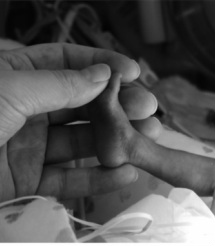 Although every premature baby's story is different, below are some common prematurity complications. Intraventricular hemorrhage (IVH): IVH is bleeding into the fluid-filled areas (ventricles) inside the brain. Prematurity (and the degree of prematurity) is a risk factor for this condition. There are four grades of IVH. Grades 1-4 indicate severity of the bleed. Learn more at NIH. Hydrocephalus: Hydrocephalus is a condition in which excess fluid accumulates in the brain. This causes widening of the ventricles and can put pressure on the brain. A common treatment for hydrocephalus is surgically placing a shunt system in the brain to rid the brain of excess fluid. Learn more at NIH. Periventricular leukomalacia (PVL): PVL is a disorder in which there is a death of white brain matter caused by lack of oxygen or blood to the periventricular portion of the brain. There is no treatment to cure this condition. There are only treatments to alleviate symptoms. Learn more at NIH. Bronchopulmonary dysplasia (BPD): BPD is caused by prolonged periods of high levels of assisted ventilation. Congenital heart disease, prematurity and severe respiratory infection are risk factors for BPD. Infants with this disorder may be fed by NG tube and require extra calories. Diuretics, corticosteroids, bronchodilators and surfactant are common medicinal treatments. Apnea: Apnea is caused by immaturity in the area of the brain that controls the drive to breathe or by illness. Intraventricular hemorrhage, intracranial hemorrhage, neonatal seizures, perinatal asphyxia,, Impairment of oxygenation from congestive heart failure and pulmonary edema (PDA, coarctation, etc.), or from shunting (cyanotic heart disease) are common risk factors. Persistent Pulmonary Hypertension (PPHN): PPHN occurs when there is a failure of the normal circulatory transition that occurs after birth. Risk factors include meconium aspiration syndrome, pneumonia, infection, low blood sugar, birth asphyxia, amniotic fluid leak and low amniotic fluid. Treatments include ventilation, nitric oxide, and ECMO. Pneumothorax: This disorder occurs when alveoli in the lung burst which leads to leaking air into the pleural space. RDS and meconium aspiration are causal factors. This condition is treated by placing a catheter into the baby's chest to remove the air. Respiratory Distress Syndrome (RDS): RDS occurs when an infant's immature lungs do not produce enough surfactant. Ventilation and surfacant are common treatments. GER disease (GERD): occurs when reflux of the gastric contents causes symptoms that affect the quality of life for an infant. The predominant cause of GERD is transient lower esophageal sphincter (LES) relaxation. Regurgitation and vomiting are the most common symptoms of infant reflux. In GERD, the reflux contains stomach acid which damages the lining of the esophagus. Feeding changes may be necessary. Medication and surgery may be necessary dependent on severity. Learn more at NIH. Hypoglycemia : This condition occurs when a neonate has low levels of blood sugar. Glucose blood levels can drop in neonates for the following reason:
Patent ductus arteriosus (PDA) : PDA is a condition in which the ductus arteriosus does not close. PDA leads to abnormal blood flow between the aorta and pulmonary artery, two major blood vessels that carry blood from the heart. Surgery may be necessary if the PDA does not close on its own. Learn more at NIH. Jaundice: is the most common condition seen in newborns. It occurs when high levels of bilirubin are exhibited in the blood. This causes yellowing of the skin. In extreme cases fatigue and poor feeding are seen. In mild cases treatment might not be necessary. The condition is simply monitored. If bilirubin levels are very high, phototherapy may be required to break down the bilirubin (as pictured). Rare complications include deafness, cerebral palsy and kernicterus (brain damage). Learn more at NIH. Comments are closed.
|
 RSS Feed
RSS Feed